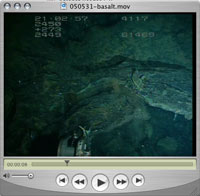|
|

 Today's Weather Sunny Lat: 00° 48.34N Long: 086° 13.66W Wind: SSW Sea State: 3 Swell Height: 3-5ft Baro Press: 1008.5MB Air Temp: 24.5°C 76.2°F Sea Temp: 26.5°C 79.7°F Vis: 8-10nm  Quicktime Movie » Windows Media Player » Alvin’s manipulator arms breaks off a piece of a sheet flow from the edge of a collapsed pit.  Hot Rocks at the Bottom of the Cold Ocean Tens of miles below the ocean bottom, high pressure and temperature cause rocks to melt and begin to flow like hot syrup. This is the birthplace of magma, molten rock that rises to the seafloor and erupts to form new ocean crust. Several scientists on our expedition are working to understand these deep-sea geologic processes. Geologist Dan Fornari, volcanologist Adam Soule, and geochemist Susan Humphris are interested in the geochemistry and textures of lava. They use seafloor photographs and rock samples to study how lava erupts at the Galapagos Rift. Tonight will be our ninth and final opportunity on this expedition to photograph the seafloor using TowCam. Tomorrow we complete our collection of rocks using Alvin. Basalt lava erupts on the seafloor at 1,100 C (2,010 F). The near-freezing seawater rapidly quenches the surface of the flow. This forms a thin crust of volcanic glass that is still pliable, and bends into fantastic shapes and textures. Under this glass crust the hot lava continues to flow and spread across the seafloor, distributing the lava hundreds to thousands of meters from its source. Erupting lava forms different textures. Some are smooth like bed sheets; others are folded like window curtains. Still others look like long strands of rope; we call this ropy lava. Different rock textures provide clues that help scientists understand how lava erupts. For example, stretch marks on big, bulbous pillow flows suggest that they slowly ooze out of eruptive fissures. Smooth sheet flows, on the other hand, spread rapidly over a relatively flat seafloor. "We would like to know where one lava flow ends and another begins,” Adam said. “This helps us to understand how much lava comes out during a single eruption.” Back on shore, scientists will combine their observations with geochemical analyses of the samples they have collected to distinguish between flows. "With so many unanswered questions about mid-ocean ridge lava flows, every piece of information can lead to important advances," Adam said. Learn more about Lava Flows
Mail Buoy Do you have questions about oceanographic research, hydrothermal vents, or about what it is like to work on board a ship? E-mail your questions to the scientists working on board RV Atlantis at divediscover@atlantis.whoi.edu. Please tell us your town and state, and keep your messages short with no attachments. Read today's mail »
|
|||||||||||||||||||||||||||||||||||||||||||||||||||||||||||||||||||||||||||||||||||||||||||||
Mailing List | Feedback | Glossary | For Teachers | About Us | Contact
© 2010 Dive and Discover™. Dive and Discover™ is a registered trademark of
Woods
Hole Oceanographic Institution

